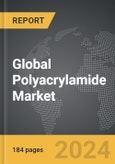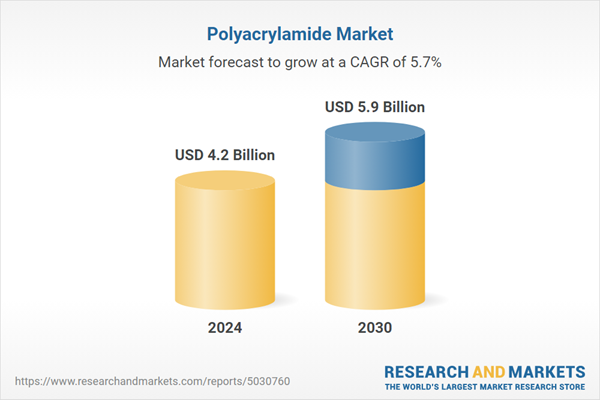The global market for Polyacrylamide was valued at US$4.2 Billion in 2024 and is projected to reach US$5.9 Billion by 2030, growing at a CAGR of 5.7% from 2024 to 2030. This comprehensive report provides an in-depth analysis of market trends, drivers, and forecasts, helping you make informed business decisions. The report includes the most recent global tariff developments and how they impact the Polyacrylamide market.
Segments: Application (Water Treatment, Pulp & Paper, Enhanced Oil Recovery, Other Applications); Type (Anionic, Cationic, Non-Ionic).
Geographic Regions/Countries: World; United States; Canada; Japan; China; Europe (France; Germany; Italy; United Kingdom; Spain; Russia; and Rest of Europe); Asia-Pacific (Australia; India; South Korea; and Rest of Asia-Pacific); Latin America (Argentina; Brazil; Mexico; and Rest of Latin America); Middle East (Iran; Israel; Saudi Arabia; United Arab Emirates; and Rest of Middle East); and Africa.
The analysts continuously track trade developments worldwide, drawing insights from leading global economists and over 200 industry and policy institutions, including think tanks, trade organizations, and national economic advisory bodies. This intelligence is integrated into forecasting models to provide timely, data-driven analysis of emerging risks and opportunities.
Global Polyacrylamide Market - Key Trends and Drivers Summarized
Versatile Polymer: Exploring the Applications of Polyacrylamide
Polyacrylamide (PAM) is a versatile polymer formed from acrylamide subunits, used extensively in various industrial and environmental applications. This synthetic polymer is produced through the polymerization of acrylamide monomers, which can be conducted via different methods, including free-radical polymerization in aqueous solution, inverse emulsion polymerization, or suspension polymerization. The resulting product can be further processed into powders, granules, or liquid forms, depending on the intended application. Polyacrylamide is available in different molecular weights and ionic forms - nonionic, anionic, and cationic - each offering unique properties that make it suitable for specific uses. The polymer’s ability to form strong hydrogen bonds with water molecules imparts it with excellent water solubility and makes it a highly effective agent in water treatment processes and various industrial applications.How Is Polyacrylamide Utilized in Water Treatment and Other Industries?
Polyacrylamide plays a crucial role in water treatment processes, acting as a flocculant to remove suspended particles and contaminants from water. In municipal and industrial wastewater treatment plants, PAM is added to water to aggregate fine particles into larger flocs, which can then be easily separated by sedimentation or filtration. This process is vital for producing clean, safe water for consumption and reducing the environmental impact of industrial effluents. Beyond water treatment, polyacrylamide is used extensively in the oil and gas industry for enhanced oil recovery (EOR) techniques, where it improves the viscosity of water injected into oil reservoirs, thereby increasing the efficiency of oil extraction. Additionally, PAM is employed in the paper manufacturing industry as a retention and drainage aid, improving the quality and efficiency of paper production. Its uses also extend to the agriculture sector, where it helps improve soil structure and reduce erosion, and in the cosmetics industry, where it is used as a thickening agent.What Are the Current Trends in Polyacrylamide Research and Applications?
The field of polyacrylamide research and application is dynamic, with ongoing advancements aimed at enhancing its performance and expanding its uses. One significant trend is the development of biodegradable and environmentally friendly polyacrylamide alternatives, addressing concerns over the environmental persistence of traditional PAM. Researchers are exploring the synthesis of PAM derivatives with improved biodegradability and reduced toxicity, making them safer for widespread use. Another trend is the optimization of PAM formulations for specific industrial applications, such as tailoring its molecular weight and ionic properties to enhance its efficiency in oil recovery or wastewater treatment. Advances in nanotechnology are also being integrated with polyacrylamide applications, such as the development of PAM-based hydrogels for drug delivery systems and biomedical engineering. These trends highlight the ongoing efforts to innovate and improve polyacrylamide’s performance, sustainability, and applicability across diverse fields.What Factors Are Driving the Growth in the Polyacrylamide Market?
The growth in the polyacrylamide market is driven by several factors, reflecting the increasing demand for effective and versatile polymers in various industries. The rising need for clean water and stringent regulations on wastewater discharge are significant drivers, as PAM plays a critical role in efficient water treatment processes. Technological advancements in oil and gas extraction, particularly in enhanced oil recovery, are boosting demand for polyacrylamide as a vital component in these techniques. The expanding paper and pulp industry is also contributing to market growth, with PAM being essential for improving paper quality and production efficiency. Additionally, the agricultural sector’s focus on sustainable practices and soil management is increasing the use of PAM for erosion control and soil conditioning. The ongoing research and development efforts to create more environmentally friendly and application-specific PAM formulations further support market expansion. These factors collectively ensure robust growth in the polyacrylamide market, underscoring its critical role in advancing industrial processes and environmental sustainability.Report Scope
The report analyzes the Polyacrylamide market, presented in terms of units. The analysis covers the key segments and geographic regions outlined below.Segments: Application (Water Treatment, Pulp & Paper, Enhanced Oil Recovery, Other Applications); Type (Anionic, Cationic, Non-Ionic).
Geographic Regions/Countries: World; United States; Canada; Japan; China; Europe (France; Germany; Italy; United Kingdom; Spain; Russia; and Rest of Europe); Asia-Pacific (Australia; India; South Korea; and Rest of Asia-Pacific); Latin America (Argentina; Brazil; Mexico; and Rest of Latin America); Middle East (Iran; Israel; Saudi Arabia; United Arab Emirates; and Rest of Middle East); and Africa.
Key Insights:
- Market Growth: Understand the significant growth trajectory of the Anionic segment, which is expected to reach US$2.7 Billion by 2030 with a CAGR of a 5.4%. The Cationic segment is also set to grow at 6.2% CAGR over the analysis period.
- Regional Analysis: Gain insights into the U.S. market, valued at $1.1 Billion in 2024, and China, forecasted to grow at an impressive 8.5% CAGR to reach $1.3 Billion by 2030. Discover growth trends in other key regions, including Japan, Canada, Germany, and the Asia-Pacific.
Why You Should Buy This Report:
- Detailed Market Analysis: Access a thorough analysis of the Global Polyacrylamide Market, covering all major geographic regions and market segments.
- Competitive Insights: Get an overview of the competitive landscape, including the market presence of major players across different geographies.
- Future Trends and Drivers: Understand the key trends and drivers shaping the future of the Global Polyacrylamide Market.
- Actionable Insights: Benefit from actionable insights that can help you identify new revenue opportunities and make strategic business decisions.
Key Questions Answered:
- How is the Global Polyacrylamide Market expected to evolve by 2030?
- What are the main drivers and restraints affecting the market?
- Which market segments will grow the most over the forecast period?
- How will market shares for different regions and segments change by 2030?
- Who are the leading players in the market, and what are their prospects?
Report Features:
- Comprehensive Market Data: Independent analysis of annual sales and market forecasts in US$ Million from 2024 to 2030.
- In-Depth Regional Analysis: Detailed insights into key markets, including the U.S., China, Japan, Canada, Europe, Asia-Pacific, Latin America, Middle East, and Africa.
- Company Profiles: Coverage of players such as Accepta, Anhui Jucheng Fine Chemicals Co.Ltd, Anhui Tianrun Chemicals Co., Ltd., Aqua Ben Corporation, Ashland, Inc. and more.
- Complimentary Updates: Receive free report updates for one year to keep you informed of the latest market developments.
Some of the 22 companies featured in this Polyacrylamide market report include:
- Accepta
- Anhui Jucheng Fine Chemicals Co.Ltd
- Anhui Tianrun Chemicals Co., Ltd.
- Aqua Ben Corporation
- Ashland, Inc.
- BASF SE
- Beijing Hengju Chemical Group Corporation
- Bio-Rad Laboratories, Inc.
- Kegao Chemical Co., Ltd.
- Kemira Oyj
- Polysciences, Inc.
- Shandong Jiahua Water Treatment Technology Co., Ltd.
- Shandong Polymer Bio-Chemicals Co., Ltd.
- SNF Group
- Solenis LLC
- Yixing Bluwat Chemicals Co. Ltd.
- Zhejiang Xinyong Biochemical Co., Ltd.
Tariff Impact Analysis: Key Insights for 2025
Global tariff negotiations across 180+ countries are reshaping supply chains, costs, and competitiveness. This report reflects the latest developments as of April 2025 and incorporates forward-looking insights into the market outlook.The analysts continuously track trade developments worldwide, drawing insights from leading global economists and over 200 industry and policy institutions, including think tanks, trade organizations, and national economic advisory bodies. This intelligence is integrated into forecasting models to provide timely, data-driven analysis of emerging risks and opportunities.
What’s Included in This Edition:
- Tariff-adjusted market forecasts by region and segment
- Analysis of cost and supply chain implications by sourcing and trade exposure
- Strategic insights into geographic shifts
Buyers receive a free July 2025 update with:
- Finalized tariff impacts and new trade agreement effects
- Updated projections reflecting global sourcing and cost shifts
- Expanded country-specific coverage across the industry
Table of Contents
I. METHODOLOGYII. EXECUTIVE SUMMARY2. FOCUS ON SELECT PLAYERSIII. MARKET ANALYSISSOUTH KOREAREST OF ASIA-PACIFICARGENTINABRAZILMEXICOREST OF LATIN AMERICAIRANISRAELSAUDI ARABIAUNITED ARAB EMIRATESREST OF MIDDLE EASTIV. COMPETITION
1. MARKET OVERVIEW
3. MARKET TRENDS & DRIVERS
4. GLOBAL MARKET PERSPECTIVE
UNITED STATES
CANADA
JAPAN
CHINA
EUROPE
FRANCE
GERMANY
ITALY
UNITED KINGDOM
SPAIN
RUSSIA
REST OF EUROPE
ASIA-PACIFIC
AUSTRALIA
INDIA
LATIN AMERICA
MIDDLE EAST
AFRICA
Companies Mentioned (Partial List)
A selection of companies mentioned in this report includes, but is not limited to:
- Accepta
- Anhui Jucheng Fine Chemicals Co.Ltd
- Anhui Tianrun Chemicals Co., Ltd.
- Aqua Ben Corporation
- Ashland, Inc.
- BASF SE
- Beijing Hengju Chemical Group Corporation
- Bio-Rad Laboratories, Inc.
- Kegao Chemical Co., Ltd.
- Kemira Oyj
- Polysciences, Inc.
- Shandong Jiahua Water Treatment Technology Co., Ltd.
- Shandong Polymer Bio-Chemicals Co., Ltd.
- SNF Group
- Solenis LLC
- Yixing Bluwat Chemicals Co. Ltd.
- Zhejiang Xinyong Biochemical Co., Ltd.
Table Information
| Report Attribute | Details |
|---|---|
| No. of Pages | 262 |
| Published | April 2025 |
| Forecast Period | 2024 - 2030 |
| Estimated Market Value ( USD | $ 4.2 Billion |
| Forecasted Market Value ( USD | $ 5.9 Billion |
| Compound Annual Growth Rate | 5.7% |
| Regions Covered | Global |









